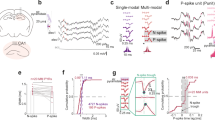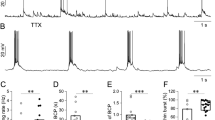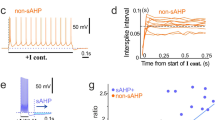Abstract
LONG lasting hyperpolarising responses following high frequency spike discharges in neurones from several sub-mammalian species have been attributed to either electrogenic ion transport1,2 or to a long lasting increase in K+ conductance3,4. These prolonged hyperpolarising responses of whatever mechanism result in alterations of neuronal behaviour which may have important functional consequences for the integrative activity of the central nervous system (CNS). Similar potentials have been reported in studies on the intact mammalian CNS5–7, but the complexity of these preparations has prevented a thorough analysis. Such phenomena can be studied using intracellular recording techniques in dissociated cell cultures of mammalian neural tissue, and here we demonstrate post-stimulus hyperpolarising responses in cultured spinal neurones and suggest the underlying mechanisms.
This is a preview of subscription content, access via your institution
Access options
Subscribe to this journal
Receive 51 print issues and online access
$199.00 per year
only $3.90 per issue
Buy this article
- Purchase on Springer Link
- Instant access to full article PDF
Prices may be subject to local taxes which are calculated during checkout
Similar content being viewed by others
References
Nakajima, S., and Takahashi, K., J. Physiol., Lond., 187, 105–127 (1966).
Thomas, R. C., Physiol. Rev., 52, 563–594 (1972).
Meech, R. W., Comp. Biochem. Physiol., 48, 387–401 (1974).
Jansen, J., and Nicholls, J. G., J. Physiol., Lond., 229, 635–655 (1973).
Kuno, M., Miyahara, J. T., and Weakly, J. N., J. Physiol., Lond., 210, 839–855 (1970).
Ransom, B. R., and Goldring, S., J. Neurophysiol., 36, 879–892 (1973).
Koike, H., Mano, N., Okada, Y., and Oshima, T., Expl Brain Res., 14, 489–503 (1972).
Peacock, J. H., Nelson, P. G., and Goldstone, M. W., Devl Biol., 30, 137–152 (1973).
Ransom, B. R., and Nelson, P. G., in Handbook of Psychopharmacology, 2, (edit. by Iversen, L. L., Iversen, S. D., and Snyder, S. H.), 101–127 (Plenum, New York, in the press).
Krnjevic, K., Physiol. Rev., 54, 418–540 (1974).
Hosli, L., Hosli, E., and Andres, P. G., Brain Res., 62, 597–602 (1973).
Thomas, R. C., J. Physiol., Lond., 201, 495–514 (1969).
Baylor, D. A., and Nicholls, J., J. Physiol., Lond., 203, 571–589 (1969).
Van Essen, D., J. Physiol., Lond., 230, 509–534 (1973).
Hammerschlag, R., and Dravid, A., Trans. Am. Soc. Neurochem., 108, (1975).
Author information
Authors and Affiliations
Rights and permissions
About this article
Cite this article
RANSOM, B., BARKER, J. & NELSON, P. Two mechanisms for poststimulus hyper-polarisations in cultured mammalian neurones. Nature 256, 424–425 (1975). https://doi.org/10.1038/256424a0
Received:
Accepted:
Issue Date:
DOI: https://doi.org/10.1038/256424a0
This article is cited by
-
Forty Years of Sodium Channels: Structure, Function, Pharmacology, and Epilepsy
Neurochemical Research (2017)
-
Variable Ca sensitivity of a K-selective channel in intact red-cell membranes
Nature (1976)
Comments
By submitting a comment you agree to abide by our Terms and Community Guidelines. If you find something abusive or that does not comply with our terms or guidelines please flag it as inappropriate.



